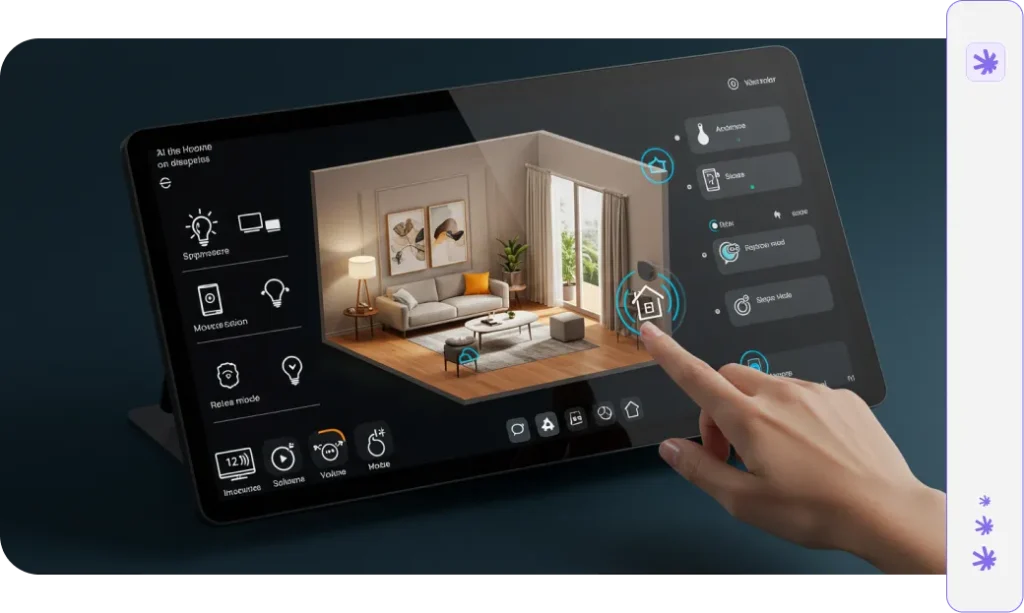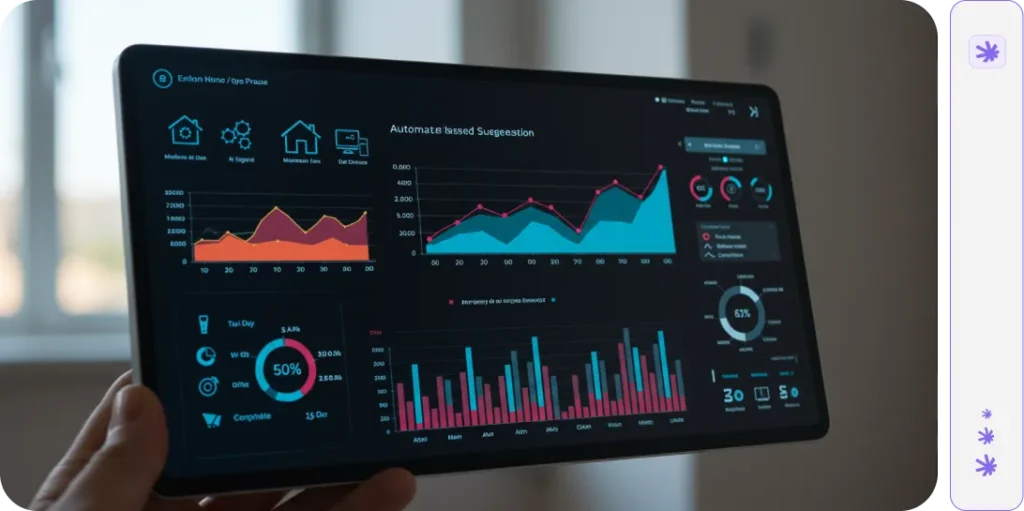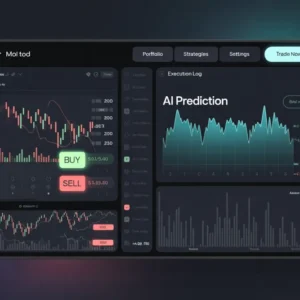AI Home Automation: Key Takeaways
- AI-powered smart homes learn your habits over time, reducing the need for manual programming by up to 60%
- Voice recognition technology now works with 98% accuracy across multiple languages and accents
- Integrating AI assistants with security systems can reduce false alarms by over 70%
- Energy consumption typically decreases 15-30% when AI manages your home utilities
- Privacy concerns can be addressed through local processing options that keep your data from cloud storage
- Initial setup costs average $500-1500 but save approximately $400 annually in utility costs
- Most modern AI automation systems function during internet outages through local processing capabilities
Introduction
Remember when clapping to turn lights on and off seemed revolutionary? I do, and I can’t help but laugh thinking about how we’d frantically clap in dark rooms hoping the technology would respond. Fast forward to today, and we’re living in a world where our homes can essentially think for themselves. AI home automation has evolved from those simple beginnings into sophisticated ecosystems that anticipate our needs before we even realize them.
The marriage between artificial intelligence and home automation isn’t just about convenience anymore—it’s creating truly intelligent living spaces that adapt to our unique patterns and preferences. But here’s the thing: most homeowners are barely scratching the surface of what’s possible. That’s why I’ve put together these five secrets that can transform your smart home from merely convenient to genuinely revolutionary.
As someone who’s implemented countless AI solutions for homes and businesses through TechMim, I’ve seen firsthand how these hidden capabilities can change the way people interact with their living spaces. Ready to unlock the full potential of your smart home? Let’s dive in.
Secret #1: AI Learns Your Patterns (Not Just Your Commands)
The biggest misconception about AI home automation is that it’s simply about voice commands and remote controls. In reality, the true power lies in how these systems learn and adapt over time.
The Learning Curve
Modern AI doesn’t just follow rules—it studies patterns. When you first install an AI home system, it might feel like you’re just replacing manual switches with voice commands. But behind the scenes, something fascinating happens: the system starts collecting data about your habits. What time do you usually wake up? When do you turn on certain lights? How do you adjust your thermostat throughout the day?
After a few weeks, your smart home begins making predictions. It might slightly warm your bathroom before your typical shower time or dim your living room lights at your usual movie hour. This isn’t based on schedules you programmed—it’s the AI recognizing patterns you didn’t even realize were patterns.
Advanced machine learning algorithms allow these systems to distinguish between your regular habits and one-off events, making them surprisingly accurate at predicting your needs. One client told me her system started preheating the oven on Thursday evenings—the exact time she’d been making pizza with her kids for months without even realizing the consistency herself.

Secret #2: Voice Recognition Has Finally Matured
Remember the frustration of early voice assistants that couldn’t understand basic commands? Those days are largely behind us, but few people realize just how sophisticated today’s voice AI has become.
Beyond Basic Commands
Today’s voice recognition doesn’t just understand what you say—it understands context, tone, and even who is speaking. Modern systems can distinguish between family members, providing personalized responses and actions based on who’s asking. This means your teenager can’t override your security settings, and your smart home can play your spouse’s favorite music when they’re the one making the request.
The contextual understanding has taken a quantum leap forward too. You can now have natural conversations with your AI assistant rather than using rigid command structures. Instead of saying “Kitchen lights on at 50% brightness,” you can say, “Make it a bit brighter in here while I’m cooking” and the system understands the context.
Multi-command processing is another breakthrough that’s often overlooked. You can string together several instructions in natural language: “Close the blinds, dim the lights, start the fireplace, and play some jazz” will be understood as a single instruction sequence rather than requiring separate commands.
Natural language processing has also evolved to understand accents and dialects that previously confused AI systems. This inclusivity means more households worldwide can benefit from voice-controlled home automation without frustration.
Secret #3: Security Integration Is More Than Just Cameras
When most people think of smart home security, they imagine doorbell cameras and motion sensors. But AI has transformed security from passive monitoring to active protection in ways many homeowners don’t realize.
Predictive Protection
AI doesn’t just record security events—it predicts and prevents them. Advanced systems analyze historical data from your home and neighborhood to establish baseline activity patterns. When something deviates from these patterns, the system can take proactive measures.
For instance, if someone approaches your property from an unusual direction at an unusual time, the system might increase camera resolution, adjust lighting, and prepare to notify you before anything concerning actually happens. This predictive capability means potential threats are often deterred before they become actual security incidents.
False alarm reduction is another breakthrough that saves homeowners significant headaches. Traditional motion sensors can’t distinguish between a burglar, your pet, or a shadow from swaying trees. AI-powered systems use computer vision to recognize the difference, reducing false alarms by over 70% while maintaining security integrity.
Behavioral analysis technology also allows these systems to recognize unusual patterns that might indicate security issues—like your back door opening at 3 AM when everyone’s asleep, or movement in rooms that should be empty while you’re on vacation.
Secret #4: Energy Management That Actually Saves Money
Smart thermostats were just the beginning. Today’s AI home automation systems take energy efficiency to levels most homeowners haven’t imagined possible.
Invisible Efficiency
The most effective energy saving doesn’t come from just turning things off—it comes from micromanaging every system in your home based on occupancy, weather patterns, utility prices, and your personal preferences. This invisible optimization happens constantly without requiring your attention.
Modern AI systems can now predict outdoor temperature changes hours before they happen by analyzing weather forecasts and historical patterns. This lets your home prepare for weather shifts proactively rather than reactively, maintaining comfort while minimizing energy use.
Time-of-use optimization is another game-changer. Your AI can shift energy-intensive activities to times when electricity rates are lowest, potentially saving hundreds annually. It might run your dishwasher at 2 AM when rates drop, or pre-cool your home before peak rate hours begin on hot afternoons.
Smart business energy solutions have now been adapted for residential use, bringing commercial-grade efficiency to your home. These systems pay for themselves faster than most people realize—typically within 12-18 months through utility savings.
Secret #5: Local Processing Keeps Your Data Private
Privacy concerns have been the biggest roadblock for many potential smart home adopters. What many don’t realize is that the newest generation of AI home automation offers robust privacy protection through local processing.
Edge Intelligence
The shift from cloud-dependent to edge processing represents one of the most significant yet least publicized advancements in home automation. Earlier smart home systems sent virtually all data to cloud servers for processing, raising legitimate privacy concerns. Today’s advanced systems process most data locally on devices within your home.
This local processing approach means your sensitive information—like when you’re home, what rooms you use, and your daily patterns—stays within your four walls. Only minimal, non-identifying data needs to leave your home for certain functions.
The privacy advantage extends beyond just keeping your data local. Advanced encryption protocols protect any information that does need to travel outside your home network. And user-friendly privacy controls let you decide exactly what information your system collects and how it’s used.
Open source home automation platforms have led this privacy revolution, creating systems that function beautifully without requiring data sharing with big tech companies. This means you can enjoy cutting-edge AI without compromising your family’s privacy.
Practical Implementation Tips
Setting up an AI-powered smart home doesn’t have to be overwhelming. Here’s how to get started without breaking the bank or losing your mind in technical complexity.
Start With a Core System
Begin with an AI hub that can grow with you rather than a collection of disconnected smart devices. Look for platforms that support open standards like Matter, which ensures compatibility with the widest range of devices. This approach creates a foundation you can build upon gradually.
Many homeowners make the mistake of purchasing numerous smart devices without a coherent integration plan. Instead, map out your automation priorities (security, energy management, convenience) and build your system methodically around these goals.
Consider starting with one room as your test area before expanding. This lets you work out integration issues on a smaller scale and develop familiarity with the technology before committing to whole-home automation.
Professional integration services can save you money in the long run by ensuring optimal setup and avoiding compatibility problems. Many TechMim clients find that a consultation early in their planning process prevents costly mistakes and creates a more coherent system.
Creating Automation Routines That Actually Help
The true power of AI automation comes from creating interconnected routines rather than individual device actions. For example, a “Good Morning” routine might gradually increase lighting, adjust temperature, prepare coffee, and brief you on your calendar—all triggered by your alarm or natural wake-up time.
Focus on automating your most frequent or annoying tasks first. This creates immediate value and helps you appreciate the system’s benefits. For many people, this includes entry/exit routines, morning preparation, and evening wind-down sequences.
Remember that good automation should disappear into the background. The best smart home doesn’t feel like technology at all—it simply makes life smoother in ways you hardly notice until you visit a non-automated home and realize how much manual work is required there.
Generative AI capabilities now allow some systems to create suggested routines based on your behavior patterns, taking the programming burden off your shoulders entirely.
Taking Your Smart Home to the Next Level
Once you’ve mastered the basics, consider these advanced strategies that separate truly intelligent homes from merely connected ones.
Multi-Sensor Integration
The most responsive homes don’t rely on single data points but combine multiple sensors to create contextual awareness. Temperature, humidity, occupancy, light levels, and even air quality sensors working together create a comprehensive picture of your home’s state.
This multi-sensor approach allows for nuanced responses. Rather than simply turning on lights when motion is detected, your home can adjust lighting based on natural light levels, time of day, and who’s in the room. This creates both energy efficiency and a more pleasant living environment.
Automation technology continues to evolve rapidly, with new sensors and integration possibilities emerging regularly. Maintaining flexibility in your system architecture allows you to incorporate these innovations as they become available.
Voice-Free Control Options
While voice control gets the most attention, truly sophisticated homes offer multiple control pathways. Gesture control, presence detection, and predictive automation reduce the need to explicitly control your home at all.
Consider implementing “scene” buttons in key locations as backup controls. These physical buttons can trigger complex automation sequences without requiring voice commands or smartphone apps—particularly useful for guests or during system updates.

Conclusion
AI home automation has evolved far beyond the novelty gadgets of just a few years ago. The five secrets we’ve explored—pattern learning, advanced voice recognition, predictive security, intelligent energy management, and privacy-focused local processing—represent a fundamental shift in how our homes can serve and protect us.
The most exciting aspect is that we’re still in the early days of this technology. As AI continues to advance, our homes will become even more intuitive, responsive, and helpful. The true promise of smart homes isn’t about technology for technology’s sake—it’s about creating living spaces that enhance our well-being, security, and comfort while respecting our privacy and preferences.
If you’re considering upgrading your home with AI automation, TechMim offers free consultations to help you design a system that meets your specific needs and budget. Our expertise in AI integration ensures you’ll get maximum value from your investment while avoiding common pitfalls and compatibility issues.
What automation features would make the biggest difference in your daily life? Share your thoughts in the comments below or reach out directly to discuss how we can help transform your living space into a truly intelligent home.
Frequently Asked Questions
What’s the typical cost to set up basic AI home automation?
Entry-level systems start around $500-800 for hub, voice assistant, and essential smart devices. Comprehensive systems typically range from $1,500-3,500 depending on home size and features desired.
Does AI home automation work during internet outages?
Yes, modern systems with local processing continue to function during outages, though cloud-dependent features may be temporarily unavailable.
How long does it take for AI to learn my household patterns?
Most systems begin showing basic pattern recognition within 1-2 weeks, with sophisticated learning continuing to improve over 1-3 months of regular use.
Can different brands of smart devices work together in one system?
Yes, especially with hubs supporting protocols like Matter, Zigbee, or Z-Wave, though some premium features may require same-brand integration.
What’s the best way to ensure privacy with smart home devices?
Choose systems with local processing options, review and adjust privacy settings regularly, and consider open-source platforms that don’t share data with third parties.
How much energy can AI home automation save?
Most households see 15-30% reduction in energy costs through intelligent management of heating, cooling, lighting and appliance usage.
Can I install an AI home system myself or do I need a professional?
Basic systems are increasingly DIY-friendly, but professional installation ensures optimal placement, proper integration, and customization for your specific needs.















